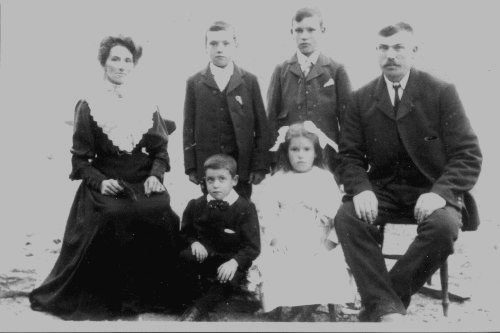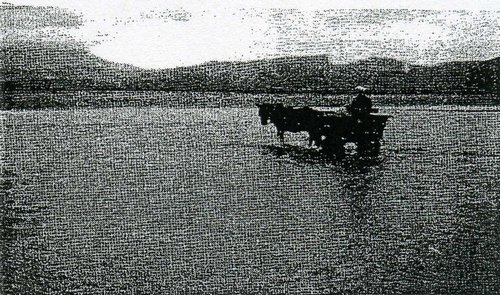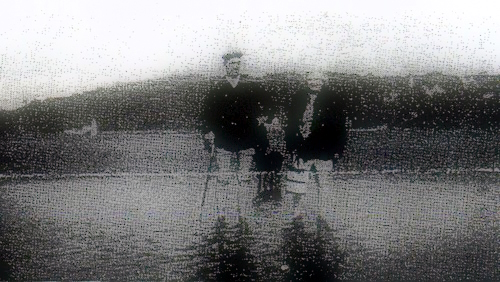YNYS GIFFTAN – LIVING ON AN ISLAND

It is not known who the author of this article is and if there is someone who knows we would be delighted to hear from you. The quality of the pictures is not good either but we have included them for their value.
How many of us have felt, occasionally, about escaping to live on an island far from everyone's reach. That has been the story of Mr Huw Williams, Minytraeth, Minffordd – spending over sixty years of his life on Ynys Gifftan. He did not escape there but was born on it because his parents had gone there to live about ten years before the end of the nineteenth century.
What was a child's life like there? Well, his education was sporadic as the tide controlled his hours at school. Some days when the tide was up it could be after eleven before he could reach Talsarnau. Having crossed to the mainland as it were, he had a another mile to walk. Arriving back home, the tide kept his friends away and he had to amuse himself with his brother and sister.
When weather permitted, they set about laying a line and catching flat fish. The river Dwyryd is a river full of ditches of which his mother was aware of so when the children were little they were only allowed to go bathing within sight of the house. As such, they were poor swimmers. Another surprise was to learn that there was no boat on the island. It could only be used at high tide, and it left little time to come and go to the village. Much more convenient was a horse and cart to carry flour and feed for the livestock to the door of the house.
 Besides the horse, the family had about two or three cows to keep them in milk and butter as well as chickens and geese. The grass on the fields was thin enough but sheep were kept on them, although they were not enough to give Huw Williams or his father before him a living. As such his father went to the quarry at Stiniog and broke his leg there without receiving a penny of compensation. He died when his son was just a thirteen-year-old lad. He left his wife to raise her family. The boys would carry gorse to fire up the brick oven and carry hay with a drag cart ensuring every piece was collected, sometimes carry it on their backs. At the age of fifteen Huw Williams went into service as a farm labourer in Dyffryn and it was there that he met the girl he married and took to live on the island. The nineteenth century was a hard few years and, like his father before him, he became a quarryman in Blaenau. He paid eleven pence a day to travel there from Talsarnau and that was from a salary of two pounds and six pence a week.
Besides the horse, the family had about two or three cows to keep them in milk and butter as well as chickens and geese. The grass on the fields was thin enough but sheep were kept on them, although they were not enough to give Huw Williams or his father before him a living. As such his father went to the quarry at Stiniog and broke his leg there without receiving a penny of compensation. He died when his son was just a thirteen-year-old lad. He left his wife to raise her family. The boys would carry gorse to fire up the brick oven and carry hay with a drag cart ensuring every piece was collected, sometimes carry it on their backs. At the age of fifteen Huw Williams went into service as a farm labourer in Dyffryn and it was there that he met the girl he married and took to live on the island. The nineteenth century was a hard few years and, like his father before him, he became a quarryman in Blaenau. He paid eleven pence a day to travel there from Talsarnau and that was from a salary of two pounds and six pence a week.
But he preferred the work of the land, despite the hardship, and for years he was a shepherd at Cefn Trefor as well as looking after the land on the Island. It was a hard life yet a happy life.
There were no close neighbours. Imagine having to paddle to go and loan a quarter of tea to Mrs Jones next door. Lord Harlech is the owner of the land and there was a picture of him in the kitchen in the house. And the name Gifftan? Well, the island was probably a gift from Queen Ann to the Lord –so they say! Another explanation and is more probable is that Gidan Island is the correct form. A young goat is called "gidan" and there is a farm called Aber Gafran on the other side of the river.
 In retirement, Mr and Mrs Williams came to live in Minffordd as Mrs Williams' health was fragile. The island is not an easy place for a doctor to go although Dr Pritchard went there at four o'clock in the morning when Huw Williams suffered appendix pains. 'I don't know if he had to paddle there and not! Mrs Williams died some years ago but Huw Williams still keeps his sight on the island as it were. No one lives there any more and nothing is to be heard but the cry of the seagulls and the slapping of the water on the rocks. For Huw Williams, it's 'a place where I previously played', where he also put in a day's hard work. He deserves to have a rest on the edge of the traeth now. Not all islands are magical after all.
In retirement, Mr and Mrs Williams came to live in Minffordd as Mrs Williams' health was fragile. The island is not an easy place for a doctor to go although Dr Pritchard went there at four o'clock in the morning when Huw Williams suffered appendix pains. 'I don't know if he had to paddle there and not! Mrs Williams died some years ago but Huw Williams still keeps his sight on the island as it were. No one lives there any more and nothing is to be heard but the cry of the seagulls and the slapping of the water on the rocks. For Huw Williams, it's 'a place where I previously played', where he also put in a day's hard work. He deserves to have a rest on the edge of the traeth now. Not all islands are magical after all.


